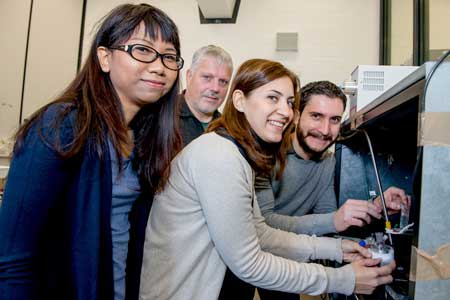| Nov 15, 2016 |
New biofuel cell with energy storage
|
|
(Nanowerk News) Researchers have developed a hybrid of a fuel cell and capacitor on a biocatalytic basis. With the aid of enzymatic processes, what's known as a biosupercapacitor efficiently generates and stores energy. The trick: the enzymes are embedded in a stable polymer gel, which can store a large amount of energy. The scientists at the Ruhr-Universität Bochum and the Swedish Malmö University describe their development in the journal Angewandte Chemie ("A Nernstian Biosupercapacitor").
|
 |
| The Bochum-based team: Piyanut Pinyou, Wolfgang Schuhmann, Sabine Alsaoub and Felipe Conzuelo (from left).
|
|
Societal challenge
|
|
Generating energy and saving it with as little loss as possible is one of the major challenges for today's society. Energy production and storage usually take place in different systems - which is inefficient. This is different in the new biosupercapacitor, which combines both processes.
|
|
"Such a technology could, for instance, be interesting for miniaturised devices, which should even supply themselves with energy wirelessly. This is particularly important for implantable miniaturised sensors," says Prof Dr Wolfgang Schuhmann from the Bochum Institute for Analytical Chemistry. He was involved in the development with his colleagues Dr Felipe Conzuelo, Dr Piyanut Pinyou and Sabine Alsaoub.
|
|
Enzymes at both electrodes
|
|
With the aid of an enzyme, the biosupercapacitor burns glucose as a fuel at one electrode. At the other electrode, an enzyme converts oxygen into water. Both enzymes must be embedded in an electron-conducting gel in order to establish the electrical contact to the electrodes. For the first time, the team used the same gel, also called a redox polymer, for both electrodes.
|
|
When charging up and storing the energy, this redox polymer at one electrode gives off electrons and is thus positively charged. At the other electrode, it takes in the electrons and is thus negatively charged. "During the discharging process, the charges equal out and a current flows," explains Schuhmann.
|
|
High capacity
|
|
The system set up in this manner showed itself to be stable in the researchers' tests and can serve as a permanent source of energy. It has a low weight and a high capacity, so it can hold a large charge. "We see this work as a starting point for future strategies in the development of new, highly functional and also affordable electrical sources of energy on bioelectrochemical basis," summarise the authors.
|

